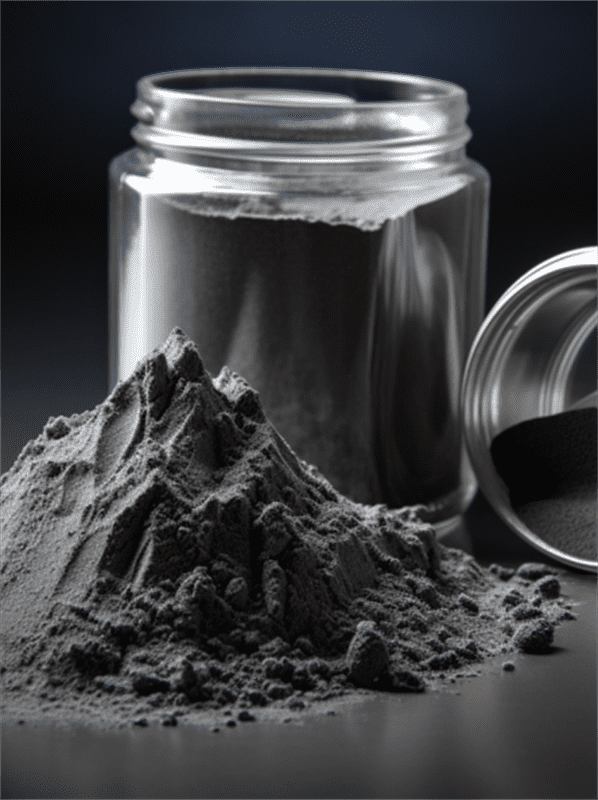使用金属粉末进行 3D 打印正在改变从航空航天到医疗等各个行业的制造业。本指南全面介绍了用于三维打印的金属粉末,包括合金类型、粉末生产方法、关键性能、应用、规格、工艺注意事项、供应商情况、成本和常见问题。它是工程师探索采用基于金属粉末的增材制造技术的技术参考资料。
介绍 用于 3D 打印的金属粉末
三维打印又称增材制造(AM),是根据数字模型逐层制造部件。使用金属粉末原料可实现工程级材料的工业级三维打印。
金属粉末 AM 的优点包括
- 机械加工无法实现的复杂几何形状
- 可大规模定制的个性化设计
- 与减法相比,减少了浪费
- 缩短原型开发时间
- 将组件合并为单个印刷部件
- 高强度和热稳定性的结果
- 即时生产的潜力
金属粉末可在航空航天、医疗、汽车和工业应用领域独特地实现高密度、高性能金属部件的三维打印。

用于 3d 打印的金属粉末 用于 AM 的类型
一系列金属和合金被用作 3D 打印的粉末原料。常见的选择包括
| 材料 | 主要特性 |
|---|---|
| 不锈钢 | 耐腐蚀、高强度 |
| 工具钢 | 极高的硬度和耐磨性 |
| 钛 | 高强度重量比 |
| 铝质 | 重量轻、导电性强 |
| 镍合金 | 耐热性、韧性 |
| 钴铬合金 | 生物相容性、硬度 |
通过选择优化合金,可以为打印部件量身定制硬度、强度、延展性和耐磨性等材料特性。
金属粉末生产方法
3D 打印粉末的常见生产方法包括
- 气体雾化 - 惰性气体将熔融合金变成球形液滴。纯度高,流动性好。
- 等离子体雾化 - 高热等离子体将合金熔化成细小的球体。内部结构清洁。
- 机械合金化 - 球磨法从元素混合物中合成合金。纳米结构颗粒。
气体雾化是最主要的方法,可以经济地大批量生产球形粉末,是大多数 AM 工艺的理想选择。
金属粉末如何实现 3D 打印
在粉末床熔融三维打印中,金属粉末被热源逐层选择性熔化:
粉末床融合 AM
- 粉末涂成薄层
- 激光或电子束熔化粉末图案
- 下一层粉撒在上一层上
- 逐层重复,直至完成
- 未熔化粉末支撑部件
- 卓越的尺寸精度和表面光洁度
细球形粉末可实现高分辨率印刷的致密包装。粒度分布必须符合印刷机的要求。
用于 AM 的金属粉末规格
用于 3D 打印的主要粉末特性包括
用于 AM 的金属粉末规格
| 参数 | 典型值 |
|---|---|
| 颗粒大小 | 10-45 微米 |
| 粒子形状 | 球形 |
| 尺寸分布 | D10、D50、D90 |
| 流动性 | 以秒/50 克为单位 |
| 表观密度 | 2.5-4.5 克/立方厘米 |
| 水龙头密度 | 高达 80% 的固体密度 |
| 纯净 | 98-99% |
| 表面氧化物 | 重量小于 1% |
这些特性直接影响到粉末包装、铺展、激光吸收、粉末再利用以及最终零件的特性。
金属粉末粒度分布
粒度范围必须符合打印机的要求:
AM 的粒径范围
| 类型 | 尺寸范围 |
|---|---|
| 细粉 | 15-25 微米 |
| 中型粉末 | 25-45 微米 |
| 粗粉 | 45-75 微米 |
- 更细的粉末可实现更高的分辨率和表面光洁度
- 较粗的粉末流动性更好,粉尘更少
理想的尺寸分布取决于打印机的品牌和型号。定制分布可优化性能。
如何为 AM 选择金属粉末
金属粉末的主要考虑因素包括
- 三维打印机 - 兼容的尺寸范围,理想的形态
- 材料特性 - 机械、物理和后处理需求
- 质量标准 - 粉末分析,批次间的一致性
- 准备时间和可用性 - 标准合金与定制
- 数量 - 大批量折扣定价
- 供应商能力 - 材料范围和专业知识
与知名粉末生产商和打印机 OEM 密切合作,确定满足应用需求的最佳材料。
用于 AM 的金属粉末供应商
全球领先的 AM 用优质金属粉末供应商包括
AM 行业金属粉末供应商
| 供应商 | 关键材料 |
|---|---|
| AP&C | 钛、铝化钛、镍合金 |
| 木匠添加剂 | 不锈钢、工具钢、钴合金 |
| 山特维克鹗 | 不锈钢、镍合金、钛 |
| 普莱克斯 | 钛、镍、钴合金 |
| LPW 技术 | 钛、铝、钢 |
| AMG 超合金英国公司 | 铝化钛、镍合金 |
这些公司在合金和 AM 工艺方面都拥有丰富的专业技术知识。有些公司还进行了垂直整合,使用其粉末进行生产、表征甚至 3D 打印。
三维打印金属粉末定价
作为一种特殊材料,金属印刷粉比传统金属粉末成本更高。定价因素:
- 组成 - 更昂贵的合金意味着更高的粉末价格
- 纯净 - 更严格的化学控制提高了成本
- 生产方法 - 专业方法的成本高于雾化方法
- 尺寸分布 - 等级越细越昂贵
- 数量 - 超过 1000 公斤的批量订单可享受折扣价
AM 典型金属粉末价格范围
| 材料 | 每公斤价格 |
|---|---|
| 不锈钢 | $25-$100 |
| 工具钢 | $50-$150 |
| 钛 | $100-$500 |
| 镍合金 | $50-$500 |
| 钴铬合金 | $100-$300 |
在为 AM 生产采购材料时,从入围供应商处获取当前价格。

金属 AM 粉末的工艺考虑因素
成功使用金属 3D 打印粉需要注意以下几点:
- 湿度控制 - 干粉可防止氢脆
- 回收利用 - 如果处理得当,未熔化的粉末最多可重复使用 ~20 次
- 筛分 - 重复使用前对粉末进行分类和筛分
- 鲜粉比率 - 与 10-30% 新粉混合后重复使用
- 处理 - 惰性环境,接地容器
- 存储 - 密封集装箱、气候控制空间
- 安全 - 爆炸风险要求采取缓解控制措施
遵循所有粉末安全预防措施和打印机 OEM 建议的程序。
金属粉末 AM 的未来
金属粉末三维打印技术的新兴发展包括
- 提高材料性能的新型合金和复合材料
- 通过多激光和高功率系统缩短打印时间
- 更大的打印封套扩大了部件尺寸能力
- 将 AM 与机械加工相结合的混合制造
- 自动后处理,如去粉和热处理
- 在航空航天和医疗等受监管行业的应用范围扩大
- 更加注重过程质量控制和可重复性
随着技术的进步,预计金属 AM 将在更多行业得到广泛应用。
常见问题
问:AM 最常用的金属粉末是什么?
答:合金 316L 不锈钢是最常见的材料之一,具有良好的可印刷性、机械性能和耐腐蚀性。
问:金属 AM 粉末的典型平均粒度范围是多少?
答:大多数金属 AM 粉的平均粒度在 15-45 微米之间。15-25 微米左右的较细粉末可提供最佳分辨率。
问:使用金属粉末时应采取哪些安全预防措施?
答:接地的导电容器可消除静电。氩气或氮气环境手套箱。粉尘防爆系统。个人防护设备。
问:金属粉末会变质或过期吗?
答:如果在密封容器中储存得当,根据合金的不同,金属粉末可以保存 1-5 年。湿度控制至关重要。
问:用于 AM 的金属粉末的纯度通常是多少?
答:98-99% 纯度是气体雾化 AM 粉末的典型纯度。纯度越高,杂质越少,最终性能越好。
问:哪些合金与生物医学植入物兼容?
答:钛和钴铬具有生物相容性,并能根据最终植入物的要求进行后处理,因此常用。
问:哪些金属 AM 打印方法使用粉末?
答:主要方法有粘合剂喷射、通过激光或电子束进行粉末床熔融以及定向能沉积。
问:与散装金属相比,金属粉末的成本有多高?
答:按每公斤计算,金属粉末比块状金属粉末贵 10 倍到 100 倍,具体取决于合金和工艺。
问:你们能打印银和金等纯金属吗?
答:是的,但为了获得更好的强度和可印刷性,合金版本更为常见。纯贵金属则具有挑战性。
有关用于 AM 的金属粉末的重要启示
- 气体雾化球形粉末支持高分辨率印刷
- 使粉末粒度分布严格符合喷码机要求
- 全球领先供应商提供合格的 AM 打印粉末
- 处理气氛控制可防止氧化和潮湿问题
- 如果筛分和混合得当,粉末最多可重复使用 20 次
- 成本高于传统金属粉末,但可实现新的几何形状
- 合金、尺寸、打印机和应用领域的不断扩展
金属粉末原料释放了数字驱动的增材制造在各工业领域的潜力。持续的进步将推动更广泛的长期应用。
